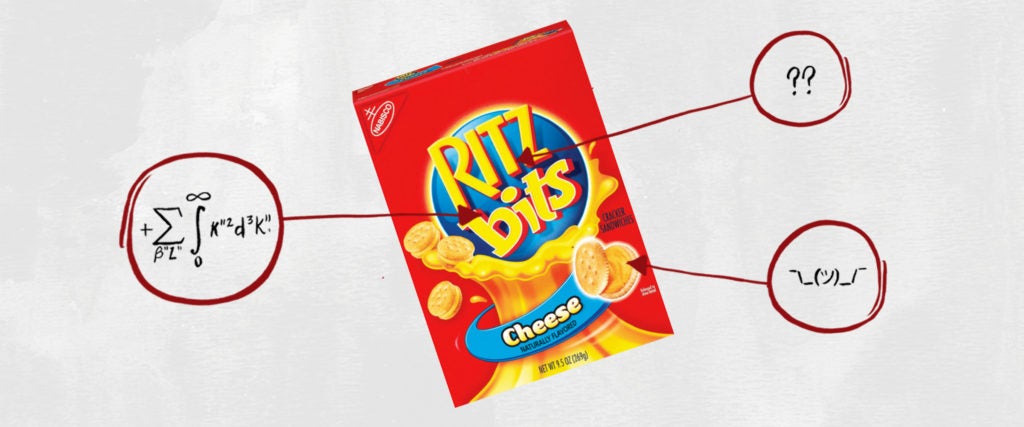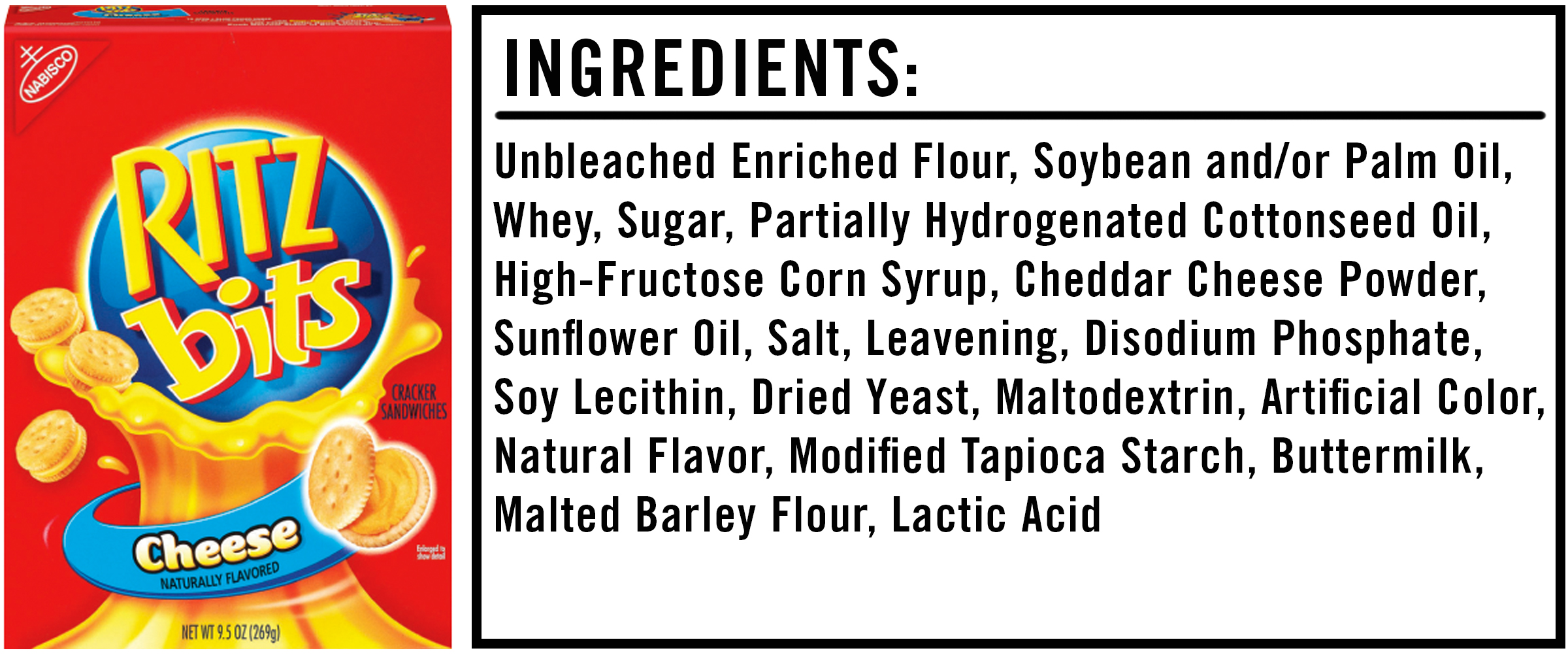We’re often told that you should never eat anything (or put anything on your body) if you don’t recognize everything on the ingredients list. But since most of us have no idea what xanthan gum or potassium benzoate are — or more importantly, what they’re doing to our bodies — we’re decoding the ingredients in the many things Americans put in (and on, or near) themselves.
This edition: Ritz Bits, which are made from 20 ingredients that we’ve broken down as they appear on the Ritz website.
The Ingredients
1) Unbleached Enriched Flour (Wheat Flour, Niacin, Reduced Iron, Thiamine Mononitrate, Riboflavin, Folic Acid): While bleached enriched flour can be quite the devious ingredient, something we explained in-depth during our analysis of the many, many, many ingredients in a McDonald’s Big Mac, unbleached enriched flour actually isn’t so bad. In fact, it boasts an assortment of vitamins and minerals, including riboflavin, which helps the body turn food into energy, and niacin, which might have the capacity to lower cholesterol, ease arthritis and even boost brain function. Still, nutritionists generally agree that unadulterated whole-wheat flour is the healthier choice.
2) Soybean and/or Palm Oil: According to physician and biochemist Cate Shanahan, consuming too much vegetable oil — which is easy to do, considering Shanahan says roughly 45 percent of the average American’s calories come from refined oils — has serious repercussions (i.e., fatty liver disease, insulin resistance and migraines). In addition to that, as we discovered during our ranking of cooking oils by how unhealthy they are, palm oil in particular is one of the least healthy oils available and absolutely terrible for the environment. Soybean oil is somewhat better, but many of the same concerns apply.
3) Whey: Whey is essentially the liquid leftovers after milk has been curdled and strained. It’s usually added to processed foods, like these Ritz Bits, as a source of protein and to add bulk.
4) Sugar: One serving of Ritz Bits (somewhere around a handful) contains four grams of sugar, which, while nothing too crazy, can add up.
5) Partially Hydrogenated Cottonseed Oil: Consuming too much vegetable oil can be bad for your health, but consuming too much partially hydrogenated vegetable oil can be even worse. When you add hydrogen to food via hydrogenation, which many manufacturers do to increase shelf life, you get trans fats. Unfortunately, trans fats raise cholesterol, harden arteries and inhibit the formation of an enzyme called cyclooxygenase, which helps determine the dilation of your arteries and regulates blood flow.
6) High-Fructose Corn Syrup: High-fructose corn syrup is a commonly-used sweetener and has been linked to obesity and diabetes by many, many studies. So, if possible, you want to avoid foods and drinks containing this ingredient.
7) Cheddar Cheese Powder (Pasteurized Milk, Cheese Culture, Salt, Enzymes): Cheese powder may sound nefarious, but as Shanahan explained to me during my analysis of Doritos, suspicious-seeming ingredients, like “cheese cultures” and “enzymes,” are actually nothing to worry about: “Starter cultures and enzymes are just used to accelerate the process of coagulating milk into cheese. Pretty much all cheese is made using some kind of enzyme to speed up the fermentation process.”
8) Sunflower Oil: Yep, more oil.
9) Salt: One serving of Ritz Bits delivers 160 milligrams of sodium, or about seven percent of your daily recommended intake.
10) Leavening (Baking Soda and/or Calcium Phosphate): Baking soda is often used as a leavening agent, helping the dough rise and become porous by increasing the surface area. The same can, more or less, be said about calcium phosphate.
11) Disodium Phosphate: Disodium phosphate is a combination of the minerals phosphorus and sodium. In powdered products, it acts as an anti-caking agent, preventing the powder from clumping together. It also works as a general stabilizer.
12) Soy Lecithin: Soy lecithin is a component of fat found in — you guessed it — soy. It’s typically added to food products as an emulsifier, which means it helps the numerous ingredients in these cheesy crackers blend together. “It’s also frequently used to extend product shelf life,” Dagan Xavier, ingredient expert and co-founder of Label Insight, told me during my analysis of the ingredients in frozen breakfast sandwiches.
13) Dried Yeast: Yeast is the fungus that makes dough rise.
14) Maltodextrin: An artificial sugar made from maltose (aka malt sugar) and dextrose (a sugar derived from starches), maltodextrin is usually used as a thickener or filler ingredient to add bulk to processed food and to increase its shelf life. (Maltodextrin itself has a shelf life of two years.)
15) Artificial Color (Includes Yellow 6): While certain artificial colors are known to be carcinogenic, including Yellow 6, Shanahan previously assured me that a normal person’s liver should have no problem breaking down whatever minuscule amounts of coloring we consume with our food.
16) Natural Flavor: Natural flavors are literally flavors derived from an actual food source — e.g., cheese flavoring taken from real cheese.
17) Modified Tapioca Starch: Modified tapioca starch is extracted from tapioca (duh), then treated physically, enzymatically or chemically to partially break down the starch. It’s probably added to Ritz Bits as a thickening agent, bulking up the cheese.
18) Buttermilk: Buttermilk is a fermented dairy product, usually put into processed foods to add heartiness and oftentimes a creamy texture.
19) Malted Barley Flour: Malted barley flour is made from barley that’s allowed to germinate. It’s then steam-dried, hulled, ground and sifted. Again, it likely adds bulk to the cheese in these Ritz Bits.
20) Lactic Acid: Lactic acid is a sugar added for acidic flavoring. It’s the main sugar in milk and can also be used to speed up the coagulation process of cheeses.
The Takeaway
There are certainly worse things to snack on, but if you want to avoid all that extra vegetable oil — and just generally pay your body and taste buds the respect they deserve — I suggest opting for real crackers and real cheese. You owe it to yourself.


